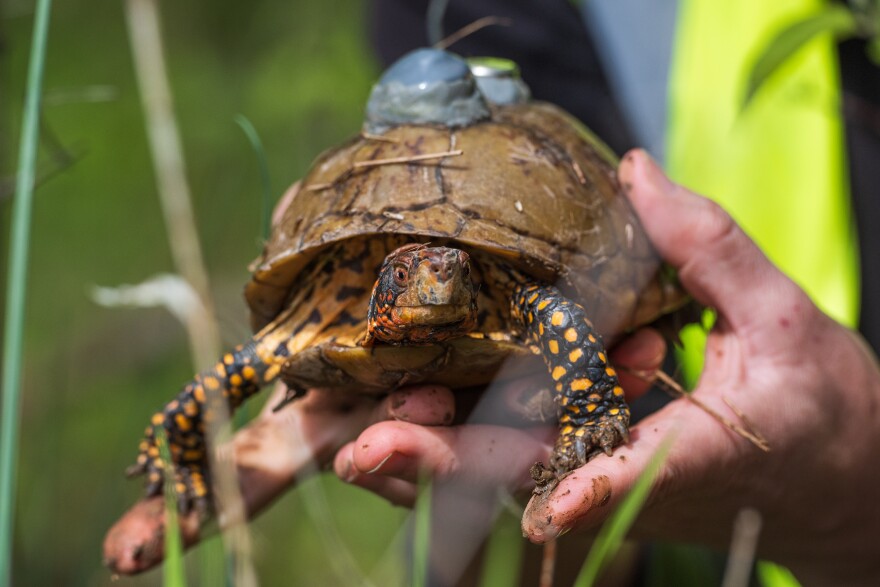Three-toed box turtles are hard to spot with the naked eye, but a finely tuned nose can often do the trick.
That's why researchers with the St. Louis Zoo’s Institute for Conservation Medicine hired a pack of dark brown, curly haired Boykin spaniels for a treasure hunt of sorts this week in a Spanish Lake wildlife park.
The dogs and zoo researchers were looking for the turtles in a quest to find out more about the emerging ranavirus, which causes respiratory disease among amphibians and reptiles. The first known case in a Missouri box turtle was discovered last year at the Ballwin Wildlife Rescue Center.
There’s a new urgency to find and track three-toed box turtles, a species native to Missouri, because little is known about how the virus is transmitted or affects different species.

“I think all of us right now, in the day of COVID, can relate to this. This doesn’t just happen to the human species,” said Dr. Sharon Deem, director of the Zoo's Institute for Conservation Medicine.
Across the Mississippi River, the ranavirus has nearly wiped out populations of eastern box turtles, with an 80% mortality rate. The virus makes it hard for turtles to breathe and causes ulcers in their mouths.
Zoo researchers are focusing their efforts on studying turtle populations within the 425-acre St. Louis Zoo WildCare Park in north St. Louis County. They hope to glue a location tracker and temperature gauge to the shiny olive shells of 10 turtles in total to study this summer.
The team of spaniels have been trained to sniff out turtle urine, a scent humans have difficulty detecting in the wild, to locate the reptiles. But April has been unusually cold, hindering the dogs’ smelling powers. They haven’t found many so far. The zoo’s team spent Wednesday trekking through muddy woods and searching sunny spots for basking turtles.

John Rucker trains the dogs at his home, off the power grid in rural Montana. For four months every year he packs the dogs into his white van and travels to help conservationists around the country.
“I’m a retired high school teacher who’s supposed to be having his golden, restful years,” he said.
Instead, Rucker stumbled into conservation in the late ‘90s because his first Boykin spaniel brought home a turtle one day.
“It was just a hobby at first, then I started getting requests from biology departments,” he said. “People wanted some turtles to put transmitters on so they could follow them.”
His regular clients include the University of Illinois and the Potawatomi tribe in Michigan, which views the box turtle as a sacred animal.

Rucker and his spaniels finished their three-day turtle hunt Wednesday at WildCare Park. So now, it’s up to the researchers to spot the reptiles.
“With all fieldwork you have to contend with nature, that’s part of the joy and sorrow of it, right? And so we’re going to end up spending a lot more human hours out here trying to find" more turtles, said Dr. Maris Brenn-White, a research fellow for the Institute for Conservation Medicine.
By this fall, zoo researchers aim to understand what strains of the ranavirus are in Missouri and how the virus affects the three-toed box turtle species. It’s part of the zoo’s larger efforts to study biodiversity in the WildCare park and minimize impact on native animals before developing the park into a “safari” experience.

Correction: Maris Brenn-White is a research fellow for the St. Louis Zoo's Institute for Conservation Medicine. A previous version of this story misstated Brenn-White’s job title.
Follow Kayla on Twitter: @_kayladrake




